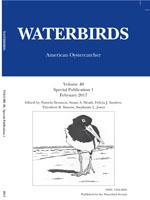The Western Atlantic population of the American Oystercatcher (Haematopus palliatus) is of conservation concern, and much effort has been exerted to determine impacts of conservation efforts and identify important sites that need increased protection within the breeding range. Monitoring numbers of nesting pairs and distribution and habitat selection of nesting pairs provides data for conservation programs. The breeding population of American Oystercatchers in North Carolina has been estimated four times since 2004. Locations of territories and nests were recorded and mapped, and sites were categorized according to habitat type (barrier, dredged-material, or natural sand-shell or marsh island) and management responsibility (Federal, State, Audubon North Carolina, private landowner). Estimates indicate the number of nesting pairs changed slightly: 324 in 2004, 346 in 2007, 373 in 2010, and 351 in 2013. Total numbers of individual American Oystercatchers during the breeding season changed from 703 in 2004 to 802 in 2013. Most nesting pairs (159.0 ± 6.0 SE; P ≤ 0.001) are on barrier islands under Federal agency management, followed by nesting pairs on natural islands (117.0 ± 7.2) and dredgedmaterial islands (69.5 ± 6.3).
How to translate text using browser tools
1 January 2017
Abundance and Distribution of American Oystercatchers (Haematopus palliatus) During the Breeding Season in North Carolina, USA
Sara H. Schweitzer,
Lindsay M. Addison,
Susan E. Cameron
ACCESS THE FULL ARTICLE

Waterbirds
Vol. 40 • No. sp1
February 2017
Vol. 40 • No. sp1
February 2017
abundance
American Oystercatcher
breeding
distribution
habitat
Haematopus palliatus
island




